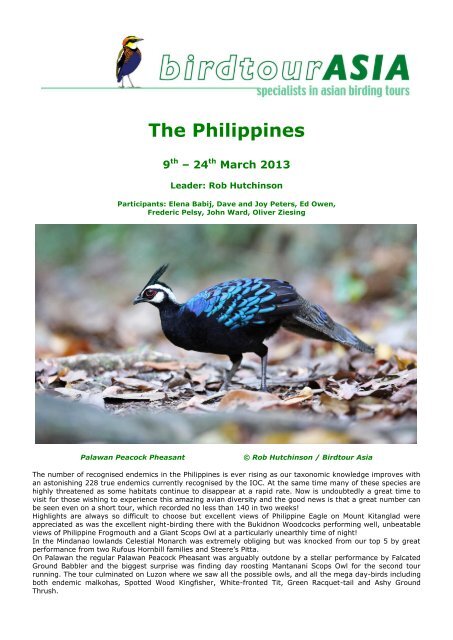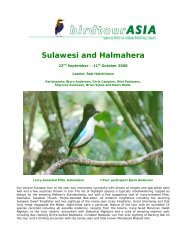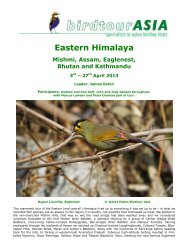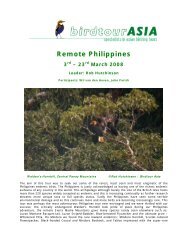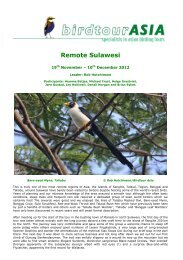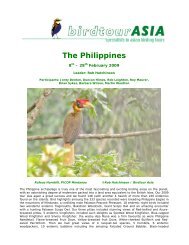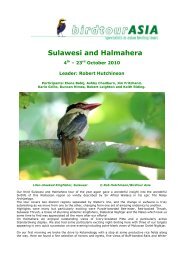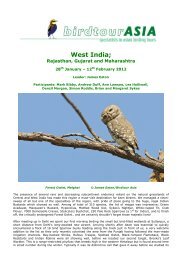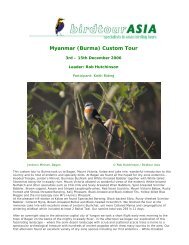The Philippines - Birdtour Asia
The Philippines - Birdtour Asia
The Philippines - Birdtour Asia
Create successful ePaper yourself
Turn your PDF publications into a flip-book with our unique Google optimized e-Paper software.
<strong>The</strong> <strong>Philippines</strong><br />
9 th – 24 th March 2013<br />
Leader: Rob Hutchinson<br />
Participants: Elena Babij, Dave and Joy Peters, Ed Owen,<br />
Frederic Pelsy, John Ward, Oliver Ziesing<br />
Palawan Peacock Pheasant<br />
© Rob Hutchinson / <strong>Birdtour</strong> <strong>Asia</strong><br />
<strong>The</strong> number of recognised endemics in the <strong>Philippines</strong> is ever rising as our taxonomic knowledge improves with<br />
an astonishing 228 true endemics currently recognised by the IOC. At the same time many of these species are<br />
highly threatened as some habitats continue to disappear at a rapid rate. Now is undoubtedly a great time to<br />
visit for those wishing to experience this amazing avian diversity and the good news is that a great number can<br />
be seen even on a short tour, which recorded no less than 140 in two weeks!<br />
Highlights are always so difficult to choose but excellent views of Philippine Eagle on Mount Kitanglad were<br />
appreciated as was the excellent night-birding there with the Bukidnon Woodcocks performing well, unbeatable<br />
views of Philippine Frogmouth and a Giant Scops Owl at a particularly unearthly time of night!<br />
In the Mindanao lowlands Celestial Monarch was extremely obliging but was knocked from our top 5 by great<br />
performance from two Rufous Hornbill families and Steere’s Pitta.<br />
On Palawan the regular Palawan Peacock Pheasant was arguably outdone by a stellar performance by Falcated<br />
Ground Babbler and the biggest surprise was finding day roosting Mantanani Scops Owl for the second tour<br />
running. <strong>The</strong> tour culminated on Luzon where we saw all the possible owls, and all the mega day-birds including<br />
both endemic malkohas, Spotted Wood Kingfisher, White-fronted Tit, Green Racquet-tail and Ashy Ground<br />
Thrush.
After meeting up in the bustling capital city of Manila we enjoyed an excellent buffet dinner and a good night’s<br />
rest before beginning our <strong>Philippines</strong> adventure with a flight south-east across the archipelago to the island of<br />
Mindanao, the second largest of more than 7100 islands in this fascinating biogeographical melting-pot. After<br />
touchdown we were soon heading south towards Bukidnon province where we would begin our tour on the<br />
Mount Kitanglad, famed as the best site to find most of those species found only in the mountains of Mindanao.<br />
Powered by an early lunch we made our way up the mountain, relieved that the good weather made our river<br />
crossing easy and the trails perfectly dry so that by mid-afternoon we had already arrived at our secluded camp<br />
in the forest edge and a striking contrast to the noise and bustle of Manila the previous night!<br />
Philippine Frogmouth, Mount Kitanglad, Mindanao<br />
Everett’s Scops Owl and Bukidnon Woodcock, Mount Kitanglad, Mindanao<br />
<strong>The</strong> walk up had already given us our first endemics like Philippine Swiftlet, Colasisi and White-eared Brown<br />
Dove, then around the camp yet more appeared including Cinnamon Ibon, Elegant Tit, Buzzing Flowerpecker<br />
and Sulphur-billed Nuthatch alongside non-endemic but still exciting Fire-breasted Flowerpecker, Mountain<br />
White-eye and Mountain Verditer. <strong>The</strong> real excitement of the day however starts as dark arrives, firstly a<br />
Philippine Nightjar calling from a nearby banana tree, then a superb display by at least three Bukidnon<br />
Woodcocks, chasing one another and calling loudly just above our heads! Our day finished in superb fashion<br />
with mind-blowingly close views of Philippine Frogmouth right next to our camp, what an amazing first day!<br />
Our second day began very early when Rob located a Giant Scops Owl next to the camp at 02.45 which stuck<br />
around for all of us to see, such an awesome bird that there were no complaints even from those trying to<br />
overcome their jetlag! Our real birding began after dawn with endemic Grey-hooded Sunbird and Olive-capped<br />
Flowerpecker the early highlights, followed closely by Rufous-headed Tailorbird, our first Mindanao Racquet-tails
zipping by and several Short-tailed Starlings. A nice forest patch yielded Philippine Cuckoo Doves and the<br />
striking Black-and-cinnamon Fantail before we arrived at a viewing place with a superb vista over the<br />
surrounding forested ridges and the ideal place to scan for the mountains, and arguably the <strong>Philippines</strong>, most<br />
prized bird, the Philippine Eagle. First to take to the skies was an adult Pinsker’s Hawk Eagle, closely followed<br />
by the resident Oriental Honey Buzzards in full ‘butterfly’ display flights and a migrant Chinese Goshawk.<br />
Despite the perfect weather THE Eagle kept us waiting quite some time before rising up from the valley below,<br />
slowly gaining height before drifting down into the hillsides opposite. Still on a high from the encounter we next<br />
added a set of White-cheeked Bullfinch feeding nearby. After an early picnic lunch most of us decided to use<br />
our time to head higher up the mountain and almost immediately reaped the rewards; Streak-breasted<br />
Rhabdornis feeding at close range in a fruiting tree, excellent views of Olive-capped Flowerpeckers and then a<br />
calling Long-tailed Ground Warbler which crossed the path nearby. A pair of McGregor’s Cuckooshrikes were<br />
next to appear, then at our furthest point, fine views of Black-masked White-eyes. A calling Blue-capped<br />
Kingfisher on the ascent which we thought had given us the slip, was fortuitously calling again when we headed<br />
back and this time we found him perched for excellent ‘scope views of this tricky bird. Mindanao Hornbill and<br />
Apo Myna completed our additions for the walk, then after yet more thrilling views of the Bukidnon Woodcocks<br />
we finished the day with yet another owl, this time a fine Everett’s Scops Owl, part of the three-way splitting of<br />
Philippine Scops Owl.<br />
Apo Myna and Blue-capped Kingfisher, Mount Kitanglad, Mindanao<br />
Olive-capped Flowerpecker and Sulphur-billed Nuthatch, Mount Kitanglad, Mindanao
<strong>The</strong> next day our aim was to hike higher up the mountain to find some of the higher altitude Mindanao<br />
endemics but there was still plenty to see along the way and we soon enjoyed excellent looks at Tawny<br />
Grassbirds, Pied Triller and Cinnamon Ibon in addition to those seen the previous day. In the open grassy areas<br />
a pair of Blue-breasted Quail were flushed, a Philippine Falconet sat atop a distant dead tree, more Stripebreasted<br />
Rhabdornis showed and the first flock of Mindanao Racquet-tails for the day zoomed past. Once we<br />
reached the higher forests McGregor’s Cuckooshrike and a funky Apo Myna appeared in quick succession,<br />
White-cheeked Bullfinch gave closer views than the previous day and a Mindanao Racquet-tail perched<br />
unobtrusively in the canopy was ‘scoped. At our highest point the target bird was Apo Sunbird and it took some<br />
time watching flowering trees and listening for calls before we finally all watched an obliging male perched up.<br />
On the walk down, those of us that stuck it out were able to get brief looks at our final possible montane<br />
endemic, the skulking Red-eared Parrotfinch, and of course we couldn’t resist more looks at the Bukidnon<br />
Woodcocks at dusk or the Giant and Everett’s Scops Owls late at night.<br />
Rufous Hornbill and Chocolate Boobook, PICOP, Mindanao<br />
Celestial Monarch and Short-crested Monarch, PICOP, Mindanao<br />
<strong>The</strong> next day was mostly a travel day but we squeezed in some birding around the camp before leaving,<br />
rewarding us with Yellow-bellied Whistler, several Buzzing Flowerpeckers, a single Fire-breasted Flowerpecker<br />
and at last, a nice perched view of Yellow-breasted Fruit Dove. <strong>The</strong> walk down to our waiting vehicle added<br />
Philippine Coucals, both Tawny and Striated Grassbirds, Philippine Cuckoo Dove and our first Red-keeled<br />
Flowerpeckers before we hit the road for the long journey all the way around the north-eastern tip of Mindanao<br />
and down to the former logging hub of Bislig on the east coast.
Bislig owes its existence to PICOP logging concession; the largest logging area ever in the <strong>Philippines</strong> which<br />
ceased operation more than 10 years ago and it is the remaining scraps of forest that we were here for.<br />
Although the remaining forest is disappearing at an alarming rate, and the area probably only has a limited<br />
remaining lifespan, the birding at the moment is still excellent!<br />
We started our first of three days here by successfully calling in the near-endemic Chocolate Boobook but were<br />
left frustrated by the calling Mindanao Boobooks that just didn’t want to show. Even during our picnic breakfast<br />
new birds appeared including our first Philippine Serpent Eagle, Yellow-wattled Bulbul, Writhed Hornbill in the<br />
‘scope and amazingly a stunning male Short-crested Monarch, one of the sites most desirable endemics!<br />
<strong>The</strong> birds continue to flow after breakfast; Philippine Falconet, a responsive Philippine Drongo Cuckoo, more<br />
Writhed together with Mindanao Hornbills, several Philippine Magpie Robins, Black-faced Coucal in the ‘scope<br />
and a pair of striking Rufous-lored Kingfisher – another key endemic. <strong>The</strong>re was barely chance to catch our<br />
breath! A pair of Philippine Orioles plucking caterpillars from a nearby tree were entertaining as Coleto chirped<br />
nearby, powerful Purple Needletails performed overhead and Scarlet Minivets of one of the distinctive Mindanao<br />
forms gonzalesi surely guaranteed us a future ‘armchair tick’.<br />
Steere’s Pitta and Philippine Needletail, PICOP, Mindanao<br />
Moving on a Yellow-bellied Whistler sang brazenly in the open as a Rufous-fronted Tailorbird hopped around it,<br />
a Red-bellied Pitta calling nearby was seen briefly before we were distracted by its endemic cousin, a Steere’s<br />
Pitta nearby, which gave views to most of us. More of the commoner species like Yellowish Bulbul and Orangetufted<br />
Spiderhunter (the Little Spiderhunter in the <strong>Philippines</strong> now split into two), Bicolored Flowerpecker, and a<br />
pair of skulking Black-headed Tailorbirds were added before we descended into some denser forest hoping for a<br />
feeding flock. Things were quite slower until Oliver brilliantly spotted a female Blue-capped Kingfisher nearby<br />
which gave excellent views, then as we walked back we were surprised by spontaneous daytime calling from a<br />
Mindanao Boobook. Not wishing to pass up an opportunity, Rob set out searching and eventually found one of<br />
the roosting birds high up in the canopy and once we finally found the ideal viewing spot, we were able to scope<br />
the bird which had only been ‘officially’ split as a full species 6 months before. As we hung around in this same<br />
area, a feeding flock finally came our way and gave us views of most of the commoner flock species like Blue<br />
Fantail, a pair of Short-crested Monarch, Rusty-crowned Babbler and a female Philippine Trogon nearby. After a<br />
picnic lunch we headed off to another forest patch and soon after arrival we were amid another feeding flock,<br />
but this time there were also Mindanao Pygmy Babblers and Philippine Leaf Warbler among the commoner<br />
species. <strong>The</strong> late afternoon was spent scanning a forest clearing but try as we might, the hoped for hornbills<br />
never appeared and the highlight was a close flyover from a Philippine Needletail, showing off its bizarre wing<br />
shape and white under-wing patches to great effect.<br />
Day two started in the same areas, this time trying to call out another Black-headed Tailorbird which had just<br />
appeared when a calling Rufous Hornbill teased us away but then went quiet. Choosing a nice forest clearing<br />
from which to scan we soon added Naked-faced Spiderhunter, more Mindanao Pygmy Babblers, Everett’s<br />
White-eye and a glowing Rufous Paradise Flycatcher. <strong>The</strong> song of a Little Slaty Flycatcher soon had us<br />
scrambling into the nearby forest, but it was firstly a group of Streaked Ground Babblers, then a Black-headed<br />
Tailorbird that showed, before the male flycatcher finally arrived to circle us several times, frequently perching<br />
in view. More views of Naked-faced Spiderhunter followed, then after a heavy downpour a Steere’s Pitta gave<br />
an amazing performance, flying straight out of the forest to land right above our heads where it called away<br />
completely unconcerned!<br />
Either side of lunch was spent searching for another feeding flock which we again tracked down in the late<br />
morning and this time the distinctive song of a Celestial Monarch got the pulses racing but he was typically<br />
elusive and the glimpses high in the canopy or flying over were not satisfactory and it remained high on our<br />
target list! More Writhed Hornbills and Philippine Needletail accompanied our lunch break, and long perched
views of Rufous-fronted Tailorbird highlighted in the early afternoon before we settled into a different clearing<br />
for the late afternoon. Many Writhed Hornbills were soon found, totalling more than 40 by the days end, and so<br />
our hopes were high but it was a long wait before the deep booms of Rufous Hornbills rang out across the<br />
forest and we headed their way hoping for views, and we were not disappointed... the family of four gave<br />
amazing looks as they twice passed overhead before perching up nearby for us to admire through the ‘scope,<br />
quite magnificent and no surprise when they were ultimately voted as bird-of-the-tour!<br />
Mindanao Pygmy Babbler and Rufous-fronted Tailorbird, PICOP, Mindanao<br />
We decide to start our final day at PICOP in this same area, hoping that the fruiting trees attracting the<br />
hornbills might also be drawing in many other species. <strong>The</strong>re were again many Writhed Hornbills in the area but<br />
also other frugivores like Philippine Fairy Bluebirds, Philippine Green Pigeon, Guaiabero and numerous<br />
Coppersmith Barbets. Heading into the nearby forest, the pulses were soon racing as the Celestial Monarch was<br />
calling again, and this time they obliged brilliantly, including several prolonged ‘scope views of the male! While<br />
watching these a pair of Blue-crowned Racquet-tails passed close overhead as did a huge Pink-bellied Imperial<br />
Pigeon just meters above our head!<br />
With the heat rising, a short spell of raptor watching produced at least two Steere’s Honey Buzzards alongside<br />
Philippine Serpent Eagle, then in spite of the midday heat we decide on a last bash for a couple of missing<br />
endemics and this paid off in fine fashion; firstly a dapper Olive-backed Flowerpecker, then a Philippine Leafbird<br />
which lived up to its name by being perfectly camouflaged as it tried to stay hidden in the foliage, and between<br />
all these was yet another magnificent Rufous Hornbill family!<br />
After another picnic lunch we headed to a rather grotty pond which has for many years been renowned as an<br />
easy place to see Southern Silvery Kingfisher. <strong>The</strong>y have become more aloof in recent years and it took some<br />
hours before one finally appeared but it was certainly worth the effort as this tiny jewel with its plumage<br />
spangled with white and topped with bright red feet, posed perfectly. From here we headed out to the rarely<br />
used airfield at Bislig only to be thwarted by torrential rain which left us with only a short time for birding,<br />
although we did still managed to find both Philippine and Wandering Whistling Ducks, Cinnamon, Black and<br />
Yellow Bitterns, Watercock, Ruddy-breasted Crake and White-browed Crake! On our way back Philippine<br />
Nightjars dotted the runway and Fred’s sharp eyes spotted an Eastern Grass Owl heading our way, which we<br />
watched float passed in the spotlight.<br />
Another travel day followed, flying first back to Manila then onwards to Palawan where we spent the night in<br />
the bustling capital Puerto Princesa ready for a whole new injection of new birds the next day. Our first morning<br />
on this decidedly tropical island was spent along the Balsahan Trail which follows the picturesque Balsahan<br />
River as it meanders through some fine lowland forest. New birds were quick to appear; Palawan Crows, Pinstriped<br />
Tit Babblers, Dark-sided Flycatcher, huge Great Slaty Woodpeckers passing overhead and our first<br />
island endemics like Lovely Sunbird, Palawan Tits, White-vented Shama, Yellow-throated Leafbird, and two<br />
recently split bulbuls; Ashy-fronted (from Olive-winged) and Palawan (from Grey-cheeked). Our two main<br />
targets here also made appearances fairly fast, firstly a dapper Palawan Flycatcher with its bright orange throat<br />
and rufous tail, barely recognisable as the dull creature depicted in the field guide! <strong>The</strong> next were a pair of<br />
Melodious Babblers which were easy to hear but difficult to catch sight of these arch skulkers, and it was some<br />
time before one finally paused in the open. Sightings of a pair of Palawan Blue Flycatchers finished our walk<br />
nicely although there were still more to add when a stop on the exit road found an obliging pair of Blue Paradise<br />
Flycatchers, Crested Serpent Eagle, Chestnut-breasted Malkoha, Black-headed Bulbul and our first Palawan<br />
Flowerpecker. A stop in the nearby rice fields was a great finish to the morning with a White-headed Stilt hiding<br />
amongst its Black-winged compatriates, Swinhoe’s Snipe, Ruff, Oriental Pratincole and numerous Long-toed<br />
Stints on offer before we celebrated with a fine seafood feast.
Palawan Tit and Palawan Flycatcher, Iwahig, Palawan<br />
Our afternoon plan was to make our way north across the island to our next destination at Sabang with birding<br />
stops along the way, the first of which was at an area of tall mangroves where it took only a few moments to<br />
find a stunning Copper-throated Sunbird together with several Pale Spiderhunters, the other half of the Little<br />
Spiderhunter split.<br />
We then had an enjoyable walk along a tree-lined stretch of road where we found yet more Palawan Tits,<br />
Common Hill Myna inspecting nest holes, Dark-throated Oriole, Sulphur-bellied Bulbul and <strong>Asia</strong>n Fairy Bluebird.<br />
Good numbers of Grey-faced Buzzards were headed northwards on their spring migration but the undoubted<br />
highlight was close views of three Palawan Hornbills, a species that can sometimes be tricky to find.<br />
We finished the day at a spectacular viewpoint with panoramic views of limestone karst forest on one side and<br />
extensive mangroves down to the coast on the other. A dark phase Changeable Hawk Eagle perched nearby<br />
kept watch as we added good flyby views of Blue-headed Racquet-tails, two more Palawan Hornbills, and<br />
wonderful prolonged views of a Philippine Cockatoo as it perched, preened and flew around the nearby hillsides.<br />
We finished the day with a spot of night-birding which gave us Large-tailed Nightjars hawking at dusk and fine<br />
views of Palawan Frogmouth.<br />
Palawan Frogmouth and Palawan Hornbill, St. Paul’s N.P., Palawan<br />
<strong>The</strong> next morning was time for one of the most eagerly anticipated parts of the tour as we boarded small outriggers<br />
for the journey out along the rugged coastline of St. Pauls National Park to the remote Subterranean<br />
River, a quality attraction in itself, but we were here to see an avian celebrity, the male Palawan Peacock<br />
Pheasant which has for more than a decade been entertaining visitors. We were not disappointed as he flaunted
his stunning plumage before us and followed us (particularly Oliver!) along the trails before retreating into the<br />
forest onto a handy fallen log and have a long series of territorial calls as he fanned his tail to flash his bright<br />
blue ocelli. It was no surprise that he won the bird of the day vote! Also in the area we enjoyed fine looks at<br />
two Hooded Pittas and after some searching a Ruddy Kingfisher, whose red tones glowed in the forest. We<br />
finished our visit here with a very obliging pair of Tabon Scrubfowl, scratching about unconcerned in the leaflitter,<br />
then a group of four Eastern Reef Egrets, three dark and one white, on rocks as we headed back. Some<br />
final late morning birding along the road gave us improved views of Blue-headed Racquet-tail, our first Brownbacked<br />
Needletail and skulking Ashy-headed Babblers. In the afternoon we took to the roads again, taking just<br />
minutes to find our first target, Spot-throated Flameback. Some excellent activity followed involving many of<br />
the species seen already with only <strong>Asia</strong>n Drongo Cuckoo, Fiery Minivet, Black-chinned Fruit Dove and a flyover<br />
Oriental Hobby new, although mega views of Great Slaty Woodpecker and many migrating Chinese Goshawk<br />
and Grey-faced Buzzard were great to see. Another night-birding session frustrated us with a calling Palawan<br />
Scops Owl only glimpsed in flight.<br />
Falcated Ground Babbler and Hooded Pitta, St. Paul’s N.P., Palawan<br />
Mantanani Scops Owl and Grey Imperial Pigeon, Honda Bay, Palawan<br />
We still had one big target left for the final morning near Sabang and our first site drew a blank again, although<br />
perched Blue-headed Racquet-tails were some compensation. Our second site looked to be heading for failure<br />
as well until a dark shape scurrying on the forest floor signalled the arrival of a pair of Falcated Ground Babbler<br />
which defied their usual skulking nature to give the most amazing performance we’ve ever had, approaching us
to just a few meters and singing in the open! We finished the morning with a visit to the beautiful white sand<br />
beach close to our resort and easily found a male Malaysian Plover.<br />
Thanks to this outstanding success we had time in the afternoon to take a boat trip out to an offshore island<br />
near Puerto Princesa with two small-island specialities, known as ‘tramp species’, as our targets. <strong>The</strong> first<br />
performed quite quickly as several Grey Imperial Pigeons gave progressively better views. Since visitors are no<br />
longer allowed to stay after dark we didn’t have high hopes of finding the other but amazingly with some<br />
diligent searching we found a day roosting Mantanani Scops Owl for the second tour running, brilliantly<br />
camouflaged by its grey plumages pressed tight up again a tree trunk. Two different Great-billed Herons<br />
roosting offshore finished off another excellent day!<br />
We used the few hours before our flight the next morning for a visit to the foreshore near town where we easily<br />
found some wintering Chinese Egrets still hanging around plus a fine selection of waders including both Lesser<br />
and Greater Sandplovers, Grey-tailed Tattlers, Red-necked Stints and Ruddy Turnstone. Even the nearby<br />
mangroves and scrub turned up Spot-throated Flameback and an obliging Oriental Reed Warbler.<br />
Spotted Wood Kingfisher, Mount Makiling and Green-backed Tailorbird at Subic Bay, Luzon<br />
<strong>The</strong>n it was time to fly back to Manila, and a short ride south of the city found us at our next destination, the<br />
forested slopes of Mount Makiling. Our first afternoon was spent around the adjacent university campus, firstly<br />
a failed attempt to find Indigo-banded Kingfisher, then we took to the grasslands with greater success, finding<br />
Spotted Buttonquail, Barred Rail and Plain Bush-hen all coming out to feed on the grassy track, besides a<br />
flyover Philippine Hawk Cuckoo, Golden-headed Cisticola and spectacular Scale-feathered Malkoha.<br />
Rufous Coucal and Luzon Flameback, Subic Bay, Luzon
Early the next morning we made our way up into the forest proper, taking the lazy option of a jeepney ride to<br />
get us higher on the mountain predawn. First to appear were a pair of Luzon Boobooks captured in the<br />
spotlight, then as day arrived a fine male Philippine Trogon and several views of an obliging Spotted Wood<br />
Kingfisher. Our first Flaming Sunbirds appeared as did Stripe-headed Rhabdornis, Elegant Tits and both Scalefeathered<br />
and Red-crested Malkoha. After battling for some time to see an elusive Luzon White-browed<br />
Sharma, another individual gave a much better show, and likewise a Grey-backed Tailorbird which moved<br />
around in forest tangles nearby. A calling Luzon Bleeding-heart caused much excitement and responded by<br />
wandering in towards us twice, seen by those looking in the right direction.<br />
White-lored Oriole and Green Racquet-tail, Subic Bay, Luzon<br />
Lowland White-eye and Ashy Ground Thrush, Manila, Luzon<br />
A large fruiting tree on our walk down was a hive of activity and those willing to suffer the neck pains of staring<br />
straight up into the canopy found Striped, Buzzing and Bicolored Flowerpeckers and Yellowish White-eyes.<br />
Our main target in the afternoon was Indigo-banded Kingfisher which was apparently absent from its previously<br />
reliable haunts. Our first alternative site drew a blank again but at the second we had delightful views of a male<br />
apparently trying to cool off in the cool of the river, against the intense afternoon humidity.<br />
A change in itinerary the next day allowed us to visit a couple of good stakeouts on the way to Subic Bay, the<br />
first sadly a blank as the juvenile Philippine Eagle Owl had chosen to roost elsewhere for the day, but the<br />
second place, an local park in metro Manila gave us superb views of Ashy Ground Thrush, Hooded Pitta, and<br />
both <strong>Asia</strong>n Emerald Dove and Lowland White-eye sitting tight on nests close to the trail. A ‘Mangrove’ Blue
Flycatcher was a good species to find here as it is likely to be split in the future, and both Kamchatka Leaf<br />
Warbler and Golden-bellied Gerygone could be found feeding in the same tree.<br />
We arrived at the well protected forests of Subic Bay, site of the former U.S. Naval Base, in time for a couple of<br />
hours birding and although it was quieter than usual we did easily add Bar-bellied Cuckooshrike, Blue-naped<br />
Parrot and Luzon Flamebacks to our list, and great looks at a juvenile Luzon Hawk Eagle circling overhead.<br />
With just a morning to find a stack of remaining endemics at Subic we certainly had our work cut out! It began<br />
successfully though with a fine Philippine Scops Owl called out for a close viewing right on the cusp of dawn.<br />
Likewise a White-fronted Tit behaved impeccably, starting to call just as day arrived and coming in close for<br />
good views as Luzon Hornbills, Blue-naped Parrots and Blackish Cuckooshrikes appeared all around us. Next<br />
star to appear was a Northern Sooty Woodpecker perched motionless atop a dead stump, then our first of<br />
several White-lored Orioles overhead. After several brief sightings a Green Racquet-tail finally performed<br />
perfectly, perching and flying right overhead several times, likewise it took two attempts for us all to see<br />
skulking Green-backed Tailorbirds but with views to just a few meters it was well worth it! Our final skulker also<br />
eventually gave in, when one from a large group of Rufous Coucals broke away to perch in open view, even<br />
cocking his tail as he preened, our final endemic of the morning which completed a superb tour as we headed<br />
back to Manila for our onward flights.<br />
<strong>The</strong> tour recorded a total of 302 species of which 8 were heard only. This included 140 species endemic to the<br />
<strong>Philippines</strong> and 7 near-endemics which are found only marginally outside the <strong>Philippines</strong> and can be considered<br />
Philippine specialities. For further information on <strong>Birdtour</strong> <strong>Asia</strong> tours to the <strong>Philippines</strong> please contact us via our<br />
e-mail or click here for our scheduled departure tours.<br />
More tour photos<br />
Mountain Verditer Flycatcher and Rusty-breasted Cuckoo, Mount Kitanglad, Mindanao<br />
Stripe-breasted Rhabdornis and Philippine Eagle, Mount Kitanglad, Mindanao
White-cheeked Bullfinch and White-eared Brown Dove, Mount Kitanglad, Mindanao<br />
Rufous Hornbill and Writhed Hornbill, PICOP, Mindanao<br />
Rufous-lored Kingfisher and Philippine Drongo Cukoo, PICOP, Mindanao
Olive-backed Flowerpecker and Rufous-fronted Tailorbird, PICOP, Mindanao<br />
Philippine Leafbird and Yellowish Bulbul, PICOP, Mindanao<br />
Black-chinned Fruit Dove and Palawan Flowerpecker, St. Paul’s N. P., Palawan
Tabon Scrubfowl and Gret Slaty Woodpecker, St. Paul’s N. P., Palawan<br />
Blue-headed Racquet-tail and Pacific Reef Egret, St. Paul’s N. P., Palawan<br />
Ruddy Kingfisher and Palawan Blue Flycatcher (female), St. Paul’s N. P., Palawan
Pale Spiderhunter and Philippine Cockatoo, St. Paul’s N. P., Palawan<br />
Systematic List<br />
White-lored Oriole and Blackish Cuckooshrike, Subic Bay, Luzon<br />
CICONIIFORMES: Ardeidae<br />
Great-billed Heron<br />
Purple Heron<br />
Eastern Great Egret<br />
Pacific Reef Heron<br />
Intermediate Egret<br />
Chinese Egret<br />
Little Egret<br />
Javan Pond Heron<br />
Striated Heron<br />
Eastern Cattle Egret<br />
Cinnamon Bittern<br />
Yellow Bittern<br />
Black Bittern<br />
Ardea sumatrana<br />
Ardea purpurea<br />
Ardea [alba] modestus<br />
Egretta sacra<br />
Egretta intermedia<br />
Egretta eulophotes<br />
Egretta garzetta<br />
Ardeola speciosa<br />
Butorides striata<br />
Bubulcus [ibis] coromandus<br />
Ixobrychus cinnamomeus<br />
Ixobrychus sinensis<br />
Dupetor flavicollis<br />
ANSERIFORMES: Anatidae<br />
Wandering Whistling Duck<br />
Dendrocygna arcuata<br />
Philippine Duck Anas luzonica e<br />
FALCONIFORMES: Accipitridae<br />
Oriental Honey Buzzard<br />
Pernis ptilorhynchus philippensis
Steere's Honey Buzzard Pernis steerei steerei e<br />
Brahminy Kite<br />
Haliastur indus<br />
Besra<br />
Accipiter virgatus quagga<br />
Chinese Goshawk<br />
Accipiter soloensis<br />
Crested Goshawk<br />
Accipiter trivirgatus palawanus<br />
Grey-faced Buzzard<br />
Butastur indicus<br />
Crested Serpent Eagle<br />
Spilornis cheela palawanensis<br />
Philippine Serpent Eagle Spilornis holospilus e<br />
Philippine Eagle Pithecophaga jefferyi e<br />
Changeable Hawk Eagle<br />
Nisaetus limnaeetus<br />
Luzon Hawk Eagle Nisaetus [philippensis] philippensis e<br />
Pinsker's Hawk Eagle Nisaetus [philippensis] pinskeri e<br />
FALCONIFORMES: Falconidae<br />
Philippine Falconet Microhierax erythrogenys e<br />
Oriental Hobby<br />
Falco severus<br />
GALLIFORMES: Megapodiidae<br />
Tabon Scrubfowl<br />
Megapodius cumingii cumingii<br />
GALLIFORMES: Phasianidae<br />
Red Junglefowl Gallus gallus philippensis heard only<br />
Palawan Peacock Pheasant Polyplectron napoleonis e<br />
Blue-breasted Quail<br />
Coturnix chinensis lineata<br />
GRUIFORMES: Turnicidae<br />
Spotted Buttonquail Turnix ocellatus e<br />
GRUIFORMES: Rallidae<br />
Barred Rail<br />
Gallirallus torquatus torqatus<br />
Ruddy-breasted Crake<br />
Porzana fusca<br />
White-browed Crake<br />
Porzana cinerea ocularis<br />
Plain Bush-hen Amaurornis olivacea e<br />
White-breasted Waterhen<br />
Amaurornis phoenicurus<br />
Watercock<br />
Gallicrex cinerea<br />
CHARADRIIFORMES: Charadriidae<br />
Grey Plover<br />
Pacific Golden Plover<br />
Little Ringed Plover<br />
Kentish Plover<br />
Malaysian Plover<br />
Lesser Sand Plover<br />
Greater Sand Plover<br />
Pluvialis squatarola<br />
Pluvialis fulva<br />
Charadrius dubius curonicus<br />
Charadrius alexandrinus<br />
Charadrius peronii<br />
Charadrius mongolus mongolus<br />
Charadrius leschenaultii<br />
CHARADRIIFORMES: Scolopacidae<br />
Common Redshank<br />
Tringa totanus<br />
Common Greenshank<br />
Tringa nebularia<br />
Green Sandpiper<br />
Tringa ochropus<br />
Wood Sandpiper<br />
Tringa glareola<br />
Marsh Sandpiper<br />
Tringa stagnatilis<br />
Common Sandpiper<br />
Actitis hypoleucos<br />
Grey-tailed Tattler<br />
Heteroscelus brevipes<br />
Ruddy Turnstone<br />
Arenaria interpres<br />
Swinhoe's Snipe<br />
Gallinago megala<br />
Bukidnon Woodcock Scolopax bukidnonensis e<br />
Rufous-necked Stint<br />
Calidris ruficollis<br />
Long-toed Stint<br />
Calidris subminuta<br />
Ruff<br />
Philomachus pugnax<br />
CHARADRIIFORMES: Glareolidae<br />
Oriental Pratincole<br />
Glareola maldivarum<br />
CHARADRIIFORMES: Recurvirostridae<br />
Black-winged Stilt<br />
White-headed Stilt<br />
Himantopus [himantopus] himantopus<br />
Himantopus [himantopus] leucocephalus<br />
CHARADRIIFORMES: Sternidae<br />
Whiskered Tern<br />
Chlidonias hybridus
COLUMBIFORMES: Columbidae<br />
Philippine ]Pompadour] Green Pigeon Treron [pompadora] axillaris e<br />
Pink-necked Green Pigeon<br />
Treron vernans<br />
White-eared Brown Dove Phapitreron leucotis e<br />
Phapitreron leucotis leucotis<br />
Phapitreron leucotis brevirostris<br />
Amethyst Brown Dove Phapitreron [amethystinus] amethystinus e<br />
Yellow-breasted Fruit Dove Ptilinopus occipitalis e<br />
Black-chinned Fruit Dove Ptilinopus leclancheri ne<br />
Pink-bellied Imperial Pigeon Ducula poliocephala e<br />
Green Imperial Pigeon<br />
Ducula aenea<br />
Ducula aenea aenea<br />
Ducula aenea palawanensis<br />
Grey Imperial Pigeon Ducula pickeringii ne<br />
Philippine Cuckoo Dove Macropygia tenuirostris e<br />
Red Collared Dove<br />
Streptopelia tranquebarica<br />
Spotted Dove<br />
Streptopelia chinensis<br />
Zebra Dove<br />
Geopelia striata<br />
Emerald Dove<br />
Chalcophaps indica<br />
Luzon Bleeding-heart Gallicolumba luzonica e<br />
PSITTACIFORMES: Psittacidae<br />
Guaiabero Bolbopsittacus lunulatus e<br />
Philippine Cockatoo Cacatua haematuropygia e<br />
Blue-naped Parrot Tanygnathus lucionensis ne<br />
Green Racquet-tail Prioniturus luconensis e<br />
Blue-crowned Racquet-tail Prioniturus discurus e<br />
Blue-headed Racquet-tail Prioniturus platenae e<br />
Mindanao Racquet-tail Prioniturus waterstradti e<br />
Colasisi Loriculus philippensis e<br />
Loriculus philippensis philippensis<br />
Loriculus philippensis apicalis<br />
CUCULIFORMES: Cuculidae<br />
Large Hawk Cuckoo Cuculus sparverioides heard only<br />
Philippine Hawk Cuckoo Cuculus pectoralis e<br />
Plaintive Cuckoo<br />
Cacomantis merulinus merulinus<br />
Rusty-breasted Cuckoo<br />
Cacomantis [sepucralis] sepucralis<br />
Violet Cuckoo<br />
Chrysococcyx xanthorhynchus amethystinus<br />
<strong>Asia</strong>n Drongo-Cuckoo<br />
Surniculus lugubris minimus<br />
Philippine Drongo-Cuckoo Surniculus [lugubris] velutinus e<br />
Common Koel<br />
Eudynamys scolopaceus mindanensis<br />
Scale-feathered Malkoha Lepidogrammus cumingi e<br />
Chestnut-breasted Malkoha<br />
Zanclostomus curvirostris harringtoni<br />
Red-crested Malkoha Dasylophus superciliosus e<br />
Greater Coucal<br />
Centropus sinensis<br />
Philippine Coucal Centropus viridis viridis e<br />
Black-faced Coucal Centropus melanops e<br />
Rufous Coucal Centropus unirufus e<br />
STRIGIFORMES: Tytonidae<br />
Eastern Grass Owl<br />
Tyto longimembris amauronota<br />
STRIGIFORMES: Strigidae<br />
Mantanani Scops Owl Otus mantananensis mantananensis ne<br />
Palawan Scops Owl Otus fuliginosus e<br />
Philippine Scops Owl Otus [megalotis] megalotis e<br />
Everett's Scops Owl Otus megalotis everetti e<br />
Giant Scops Owl Mimizuku gurneyi e<br />
Chocolate Boobook Ninox randi ne<br />
Luzon Boobook Ninox [philippensis] philippensis e<br />
Mindanao Boobook Ninox [philippensis] spilocephala e<br />
Spotted Wood Owl Strix seloputo wiepkeni heard only<br />
CAPRIMULGIFORMES: Podargidae<br />
Philippine Frogmouth Batrachostomus septimus e<br />
Palawan Frogmouth Batrachostomus [javensis] chaseni e
CAPRIMULGIFORMES: Caprimulgidae<br />
Great Eared Nightjar<br />
Eurostopodus macrotis macrotis<br />
Large-tailed Nightjar<br />
Caprimulgus macrurus<br />
Philippine Nightjar Caprimulgus manillensis e<br />
APODIFORMES: Apodidae<br />
Island Swiflet Aerodramus [vanikornensis] amelis e<br />
Palawan Swiftlet Aerodramus [vanikornensis] palawensis ne<br />
Philippine Swiftlet Aerodramus mearnsi e<br />
Germain's [Edible-nest] Swiftlet<br />
Aerodramus [fuciphaga] germani<br />
Glossy Swiftlet<br />
Collocalia esculenta<br />
Collocalia esculenta bagobo<br />
Collocalia esculenta subsp. Palawan<br />
Grey-rumped [Glossy] Swiftlet Collocalia [esculenta] marginata e<br />
Pygmy Swiftlet Collocalia troglodytes e<br />
Philippine Needletail Mearnsia picina e<br />
Brown-backed Needletail<br />
Hirundapus giganteus<br />
Purple Needletail<br />
Hirundapus celebensis<br />
House Swift<br />
Apus [affinis] nipalensis<br />
<strong>Asia</strong>n Palm Swift<br />
Cypsiurus balasiensis pallidior<br />
APODIFORMES: Hemiprocnidae<br />
Whiskered Treeswift<br />
Hemiprocne comata major<br />
TROGONIFORMES: Trogonidae<br />
Philippine Trogon Harpactes ardens e<br />
Harpactes ardens luzoniensis<br />
Harpactes ardens ardens<br />
CORACIIFORMES: Coraciidae<br />
Common Dollarbird<br />
Eurystomus orientalis<br />
CORACIIFORMES: Alcedinidae<br />
Common Kingfisher<br />
Alcedo atthis bengalensis<br />
Indigo-banded Kingfisher Alcedo cyanopecta cyanopecta e<br />
Silvery Kingfisher Alcedo argentata argentata e<br />
Rufous-backed Kingfisher<br />
Ceyx rufidorsa<br />
Stork-billed Kingfisher<br />
Pelargopsis capensis gouldi<br />
Ruddy Kingfisher<br />
Halcyon coromanda<br />
White-throated Kingfisher Halcyon [smyrnensis] gularis e<br />
Rufous-lored Kingfisher Todirhamphus winchelli mindanensis e<br />
Collared Kingfisher<br />
Todirhamphus chloris<br />
Spotted Wood Kingfisher Actenoides lindsayi lindsayi e<br />
Blue-capped Wood Kingfisher Actenoides hombroni e<br />
CORACIIFORMES: Meropidae<br />
Rufous-crowned Bee-eater Merops [viridis] americanus e<br />
Blue-tailed Bee-eater<br />
Merops philippinus<br />
CORACIIFORMES: Bucerotidae<br />
Luzon Hornbill Penelopides [panini] manillae e<br />
Mindanao Hornbill Penelopides [panini] affinis e<br />
Writhed Hornbill Aceros leucocephalus e<br />
Palawan Hornbill Anthracoceros marchei e<br />
Rufous Hornbill Buceros hydrocorax mindanensis e<br />
PICIFORMES: Capitonidae<br />
Coppersmith Barbet<br />
Megalaima haemacephala<br />
Megalaima haemacephala haemacephala<br />
Megalaima haemacephala mindanensis<br />
PICIFORMES: Picidae<br />
Philippine Pygmy Woodpecker Dendrocopos maculatus e<br />
Dendrocopos maculatus validirostris<br />
Dendrocopos maculatus fulvifasciatus<br />
Northern Sooty Woodpecker Mulleripicus [funebris] funebris e<br />
Great Slaty Woodpecker<br />
Mulleripicus pulverulentus
White-bellied Woodpecker<br />
Dryocopus javensis<br />
Luzon [Greater] Flameback Chrysocolaptes [lucidus] haematribon e<br />
Buff-spotted [Greater] Flameback Chrysocolaptes [lucidus] lucidus e heard only<br />
Spot-throated [Common] Flameback Dinopium [javanense] everetti e<br />
PASSERIFORMES: Pittidae<br />
Red-bellied Pitta<br />
Hooded Pitta<br />
Erythropitta erythrogaster<br />
Erythropitta erythrogaster propinqua<br />
Erythropitta erythrogaster erythrogaster<br />
Pitta sordida<br />
Pitta sordida palawanensis<br />
Pitta sordida sordida<br />
Steere's Pitta Pitta steerii e<br />
PASSERIFORMES: Hirundinidae<br />
Barn Swallow<br />
Pacific Swallow<br />
Striated Swallow<br />
Hirundo rustica<br />
Hirundo tahitica<br />
Cecropis striolata<br />
PASSERIFORMES: Campephagidae<br />
Bar-bellied Cuckooshrike<br />
Coracina striata striata<br />
Blackish Cuckooshrike Coracina coerulescens e<br />
McGregor's Cuckooshrike Coracina mcgregori e<br />
Pied Triller<br />
Lalage nigra chilensis<br />
Ashy Minivet<br />
Pericrocotus divaricatus<br />
Fiery Minivet<br />
Pericrocotus igneus<br />
Scarlet Minivet<br />
Pericrocotus speciosus gonzalesi<br />
PASSERIFORMES: Chloropseidae<br />
Philippine Leafbird Chloropsis flavipennis e<br />
Yellow-throated Leafbird Chloropsis palawanensis e<br />
PASSERIFORMES: Aegithinidae<br />
Common Iora<br />
Aegithina tiphia<br />
PASSERIFORMES: Pycnonotidae<br />
Black-headed Bulbul<br />
Yellow-vented Bulbul<br />
Yellow-wattled Bulbul<br />
Pycnonotus atriceps<br />
Pycnonotus goiavier<br />
Pycnonotus urostictus<br />
Pycnonotus urostictus urostictus<br />
Pycnonotus urostictus philippensis<br />
Ashy-fronted [Olive-winged] Bulbul Pycnonotus [plumosus] cinereifrons e<br />
Palawan [Grey-cheeked] Bulbul Criniger [bres] frater e<br />
Sulphur-bellied Bulbul Iole palawanensis e<br />
Philippine Bulbul Hypsipetes [Ixos] philippinus e<br />
Yellowish Bulbul Ixos everetti everetti e<br />
PASSERIFORMES: Dicruridae<br />
Sunda [Ashy] Drongo<br />
Dicrurus [leucophaeus] leucophaeus<br />
Luzon Balicassiao Dicrurus [balicassius] balicassius e<br />
Palawan Drongo Dicrurus [hottentottus] palawanensis e<br />
Mindanao Drongo Dicrurus [bracteatus] striatus e<br />
PASSERIFORMES: Oriolidae<br />
Dark-throated Oriole<br />
Oriolus xanthonotus<br />
Philippine Oriole Oriolus steerii e<br />
White-lored Oriole Oriolus [steerii] albiloris e<br />
Black-naped Oriole<br />
Oriolus chinensis<br />
Oriolus chinensis chinensis<br />
Oriolus chinensis yamamurae<br />
PASSERIFORMES: Irenidae<br />
Philippine Fairy Bluebird Irena cyanogastra e<br />
<strong>Asia</strong>n Fairy Bluebird<br />
Irena puella tweeddalei<br />
PASSERIFORMES: Corvidae
Palawan [Slender-billed] Crow Corvus [enca] pusillus e<br />
Eastern Jungle [Large-billed] Crow Corvus [macrorhynchos] levaillantii<br />
PASSERIFORMES: Paridae<br />
Palawan Tit Parus amabilis e<br />
Elegant Tit Parus elegans e<br />
Parus elegans elegans<br />
Parus elegans mindanensis<br />
Luzon White-fronted Tit Parus [semilarvatus] semilarvatus e<br />
PASSERIFORMES: Sittidae<br />
Sulphur-billed Nuthatch Sitta oenochlamys e<br />
PASSERIFORMES: Rhabdornithidae<br />
Stripe-headed Rhabdornis Rhabdornis mystacalis e<br />
Rhabdornis mystacalis mystacalis<br />
Rhabdornis mystacalis minor<br />
Stripe-breasted Rhabdornis Rhabdornis [inornatus] alaris e<br />
PASSERIFORMES: Timaliidae<br />
Ashy-headed Babbler Malacocincla cinereiceps e<br />
Melodious Babbler Malacopteron palawanense e<br />
Falcated Ground Babbler Ptilocichla falcata e<br />
Streaked Ground Babbler Ptilocichla mindanensis e<br />
Mindanao Pygmy Babbler Sterrhoptilus [plateni] plateni e<br />
Rusty-crowned Babbler Sterrhoptilus capitalis e<br />
Pin-striped Tit Babbler<br />
Macronous gularis woodi<br />
Brown Tit Babbler Macronous striaticeps e<br />
PASSERIFORMES: Turdidae<br />
White-browed Shortwing Brachypteryx montana mindanensis heard only<br />
Philippine [Oriental] Magpie Robin Copsychus [saularis] deuteronymus e<br />
Luzon White-browed Shama Copsychus [luzoniensis] luzoniensis e<br />
White-vented Shama Copsychus niger e<br />
Pied Bushchat<br />
Saxicola caprata<br />
Ashy Ground Thrush Zoothera cinerea e<br />
Eye-browed Thrush<br />
Turdus obscurus<br />
PASSERIFORMES: Acanthizidae<br />
Golden-bellied Gerygone<br />
Gerygone sulphurea<br />
PASSERIFORMES: Sylviidae<br />
Arctic Warbler Phylloscopus borealis heard only<br />
Kamchatka Leaf Warbler<br />
Phylloscupus examinandus<br />
Philippine Leaf Warbler Phylloscopus olivaceus e<br />
Mountain Leaf Warbler<br />
Phylloscopus nigrorum flavostriatus<br />
Clamorous Reed Warbler<br />
Acrocephalus stentoreus harterti<br />
Oriental Reed Warbler<br />
Acrocephalus orientalis<br />
Tawny Grassbird<br />
Megalurus timoriensis tweeddalei<br />
Striated Grassbird<br />
Megalurus palustris forbesi<br />
Middendorff's Grasshopper Warbler Locustella ochotensis heard only<br />
Green-backed [Philippine] Tailorbird Orthotomus [castaneiceps] chloronotus e<br />
Rufous-fronted [Philippine] Tailorbird Orthotomus [castaneiceps] frontalis e<br />
Grey-backed Tailorbird Orthotomus derbianus e<br />
Rufous-headed Tailorbird Orthotomus [cuculatus] heterolaemus e<br />
Rufous-tailed Tailorbird<br />
Orthotomus sericeus<br />
Black-headed Tailorbird Orthotomus nigriceps e<br />
PASSERIFORMES: Cisticolidae<br />
Bright-capped Cisticola<br />
Cisticola exilis<br />
Long-tailed Ground Warbler Bradypterus caudatus unicolor e<br />
PASSERIFORMES: Muscicapidae<br />
Dark-sided Flycatcher Muscicapa sibirica e<br />
Grey-streaked Flycatcher<br />
Muscicapa griseisticta<br />
Mountain Verditer Flycatcher<br />
Eumyias panayensis nigriloris<br />
Mugimaki Flycatcher Ficedula mugimaki heard only<br />
Snowy-browed Flycatcher<br />
Ficedula hyperythra montigena
Little Slaty Flycatcher Ficedula basilanica e<br />
Palawan Flycatcher Ficedula platenae e<br />
Little Pied Flycatcher<br />
Ficedula westermanni<br />
Palawan Blue Flycatcher Cyornis lemprieri e<br />
Mangrove Blue Flycatcher<br />
Cyornis rufigastra philippensis<br />
PASSERIFORMES: Rhipiduridae<br />
Philippine Pied Fantail Rhipidura [javanica] nigritorquis e<br />
Mindanao Blue Fantail Rhipidura [superciliaris] superciliaris e<br />
Black-and-cinnamon Fantail Rhipidura nigrocinnamomea e<br />
PASSERIFORMES: Muscicapidae<br />
Rufous Paradise Flycatcher Terpsiphone cinnamomea cinnamomea ne<br />
Blue Paradise Flycatcher Terpsiphone cyanescens e<br />
Black-naped Monarch<br />
Hypothymis azurea azurea<br />
Celestial Monarch Hypothymis coelestis e<br />
Short-crested Monarch Hypothymis helenae e<br />
PASSERIFORMES: Pachycephalidae<br />
Yellow-bellied Whistler Pachycephala philippinensis apoensis e<br />
PASSERIFORMES: Motacillidae<br />
Grey Wagtail<br />
Eastern Yellow Wagtail<br />
White Wagtail<br />
Paddyfield Pipit<br />
Motacilla cinerea<br />
Motacilla tschutschensis simillima<br />
Motacilla alba subsp.<br />
Anthus rufulus lugubris<br />
PASSERIFORMES: Artamidae<br />
White-breasted Wood-swallow<br />
Artamus leucorynchus<br />
PASSERIFORMES: Laniidae<br />
Long-tailed Shrike<br />
Brown Shrike<br />
Lanius schach nasutus<br />
Lanius cristatus lucionensis<br />
PASSERIFORMES: Sturnidae<br />
Short-tailed Starling<br />
Aplonis minor todayensis<br />
<strong>Asia</strong>n Glossy Starling<br />
Aplonis panayensis<br />
Coleto Sarcops calvus e<br />
Crested Myna<br />
Acridotheres cristatellus<br />
Apo Myna Basilornis miranda e<br />
Common Hill Myna<br />
Gracula religiosa palawanensis<br />
PASSERIFORMES: Nectariniidae<br />
Plain-throated Sunbird<br />
Anthreptes malacensis paraguae<br />
Grey-throated Sunbird Anthreptes griseigularis griseigularis e<br />
Copper-throated Sunbird<br />
Leptocoma calcostetha<br />
Olive-backed Sunbird<br />
Cinnyris jugularis<br />
Cinnyris jugularis aurora<br />
Cinnyris jugularis jugularis<br />
Purple-throated Sunbird<br />
Leptocoma sperata<br />
Leptocoma sperata sperata<br />
Leptocoma sperata trochilus<br />
Flaming Sunbird Aethopyga flagrans flagrans e<br />
Grey-hooded Sunbird Aethopyga primigenia primigenia e<br />
Metallic-winged Sunbird Aethopyga pulcherrima pulcherrima e<br />
Apo Sunbird Aethopyga boltoni malindangensis e<br />
Lovely Sunbird Aethopyga [shelleyi] shelleyi e<br />
Handsome Sunbird Aethopyga [shelleyi] bella e<br />
Naked-faced Spiderhunter Arachnothera clarae clarae e<br />
Orange-tufted [Little] Spiderhunter Arachnothera [longirostra] flammifera<br />
Pale [Little] Spiderhunter<br />
Arachnothera [longirostra] dilutior<br />
PASSERIFORMES: Dicaeidae<br />
Olive-backed Flowerpecker Prionochilus olivaceus olivaceus e<br />
Palawan Flowerpecker Prionochilus plateni e<br />
Striped Flowerpecker Dicaeum aeruginosum striatissimum e<br />
Olive-capped Flowerpecker Dicaeum nigrilore nigrilore e
Bicolored Flowerpecker Dicaeum bicolor e<br />
Red-keeled Flowerpecker Dicaeum australe e<br />
Buzzing Flowerpecker Dicaeum hypoleucum e<br />
Dicaeum hypoleucum obscurum<br />
Dicaeum hypoleucum pontifex<br />
Orange-bellied Flowerpecker<br />
Dicaeum trigonostigma cinereigularis<br />
Fire-breasted Flowerpecker<br />
Dicaeum ignipectus apo<br />
Pygmy Flowerpecker Dicaeum pygmaeum e<br />
Dicaeum pygmaeum palawanorum<br />
Dicaeum pygmaeum pygmaeum<br />
PASSERIFORMES: Zosteropidae<br />
Lowland White-eye Zosterops meyeni meyeni e<br />
Everett's White-eye<br />
Zosterops everetti basilanicus<br />
Yellowish White-eye Zosterops nigrorum innominatus e<br />
Mountain White-eye<br />
Zosterops montanus vulcani<br />
Black-masked White-eye Lophozosterops goodfellowi goodfellowi e<br />
Cinnamon Ibon Hypocryptadius cinnamomeus e<br />
PASSERIFORMES: Passeridae<br />
Eurasian Tree Sparrow<br />
Passer montanus<br />
PASSERIFORMES: Estrildidae<br />
Red-eared Parrotfinch Erythrura coloria e<br />
White-bellied Munia<br />
Lonchura leucogastra<br />
Scaly-breasted Munia<br />
Lonchura punctulata<br />
Black-headed Munia<br />
Lonchura atricapilla<br />
PASSERIFORMES: Fringillidae<br />
White-cheeked Bullfinch Pyrrhula leucogenis steerei e<br />
Mammals<br />
Davao Squirrel Sundasciurus davensis e<br />
Northern Palawan Tree Squirrel Sundasciurus juvencus e<br />
Little Golden-mantled Flying Fox Pteropus pumilus e<br />
Large Flying Fox<br />
Pteropus vampyrus<br />
Long-tailed Macaque<br />
Macaca fascicularis<br />
Philippine Cockatoo, Palawan<br />
© Rob Hutchinson / <strong>Birdtour</strong> <strong>Asia</strong><br />
<strong>The</strong> tour recorded a total of 302 species of which 8 were heard only. This included 140 species endemic to the<br />
<strong>Philippines</strong> and 7 near-endemics which are found only marginally outside the <strong>Philippines</strong> and can be considered<br />
Philippine specialities. For further information on <strong>Birdtour</strong> <strong>Asia</strong> tours to the <strong>Philippines</strong> please contact us via our e-<br />
mail or click here for our scheduled departure tours.


